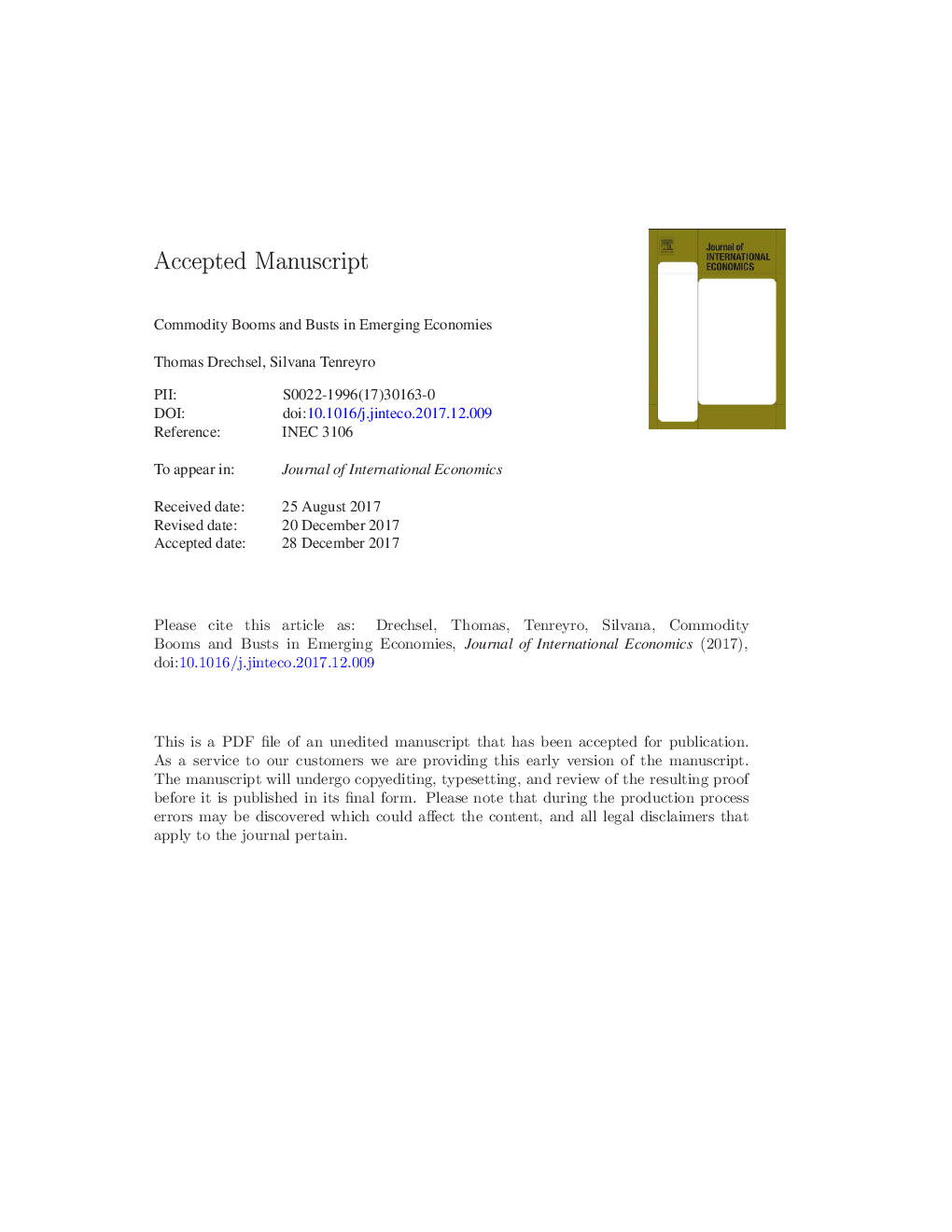| کد مقاله | کد نشریه | سال انتشار | مقاله انگلیسی | نسخه تمام متن |
|---|---|---|---|---|
| 7363929 | 1479072 | 2018 | 54 صفحه PDF | دانلود رایگان |
عنوان انگلیسی مقاله ISI
Commodity booms and busts in emerging economies
ترجمه فارسی عنوان
رونق و بس کالا در اقتصادهای نوظهور
دانلود مقاله + سفارش ترجمه
دانلود مقاله ISI انگلیسی
رایگان برای ایرانیان
کلمات کلیدی
ترجمه چکیده
اقتصادهای نوظهور، به ویژه کسانی که وابسته به صادرات کالایی هستند، مستعد ابتلا به چرخه اقتصادی بسیار مخرب هستند. این مقاله یک مدل اقتصاد باز باز برای یک صادر کننده خالص کالا را پیشنهاد می کند تا به طور کمی تحقیقاتی راجع به این چرخه ها را مطالعه کند. اقتصاد متشکل از دو بخش است، یکی از آنها کالاها را با قیمت هایی که نوسانات بین المللی خارجی دارند، تولید می کند. این نوسانات بر رقابت اقتصادی و شرایط قرض گرفتن تأثیر می گذارد، زیرا قیمت کالاهای بالاتر با نرخ پایین تر نرخ بهره و نرخ بهره در جهان همراه است. هر دو اثر به طور مشترک منجر به اثرات بسیار مثبت افزایش قیمت کالاها در تولید ناخالص داخلی، مصرف و سرمایه گذاری و تأثیر منفی بر تراز تجاری می شود. علاوه بر این، نوسانات بیش از حد مصرف بیش از خروجی و نوسانات شدید سرمایه گذاری را تولید می کند. ساختار مدل، علاوه بر اینکه به صراحت شامل نقش دوگانه قیمت کالاها می شود، منبع مختلف شواهد کاندیدایی را که در کار قبلی در چرخه های تجاری اقتصاد نوظهور ارائه شده است، به وجود می آورد. برآورد مدل بر روی داده های آرژانتینی، ما دریافتیم که سهم شوک قیمت کالاها در نوسانات رشد تولید پس از سال 1950 در حدود 38 درصد است. علاوه بر این، قیمت کالاها به ترتیب 42 و 61 درصد از تغییرات در مصرف و رشد سرمایه گذاری را تشکیل می دهد. ما شوک های بهره وری گذرا را به عنوان یک ریسک مهم نوسانات تولید در بر می داریم که بیش از سهم شوک ها در روند، که، هرچند کوچکتر، نادیده انگاشته می شود.
موضوعات مرتبط
علوم انسانی و اجتماعی
اقتصاد، اقتصادسنجی و امور مالی
اقتصاد و اقتصادسنجی
چکیده انگلیسی
Emerging economies, particularly those dependent on commodity exports, are prone to highly disruptive economic cycles. This paper proposes a small open economy model for a net commodity exporter to quantitatively study the triggers of these cycles. The economy consists of two sectors, one of which produces commodities with prices subject to exogenous international fluctuations. These fluctuations affect both the competitiveness of the economy and its borrowing terms, as higher commodity prices are associated with lower spreads between the country's borrowing rate and world interest rates. Both effects jointly result in strongly positive effects of commodity price increases on GDP, consumption, and investment, and a negative effect on the total trade balance. Furthermore, they generate excess volatility of consumption over output and a large volatility of investment. Besides explicitly incorporating a double role of commodity prices, the model structure nests the various candidate sources of shocks proposed in previous work on emerging economy business cycles. Estimating the model on Argentine data, we find that the contribution of commodity price shocks to fluctuations in post-1950 output growth is in the order of 38%. In addition, commodity prices account for around 42% and 61% of the variation in consumption and investment growth, respectively. We find transitory productivity shocks to be an important driver of output fluctuations, exceeding the contribution of shocks to the trend, which, though smaller, is not negligible.
ناشر
Database: Elsevier - ScienceDirect (ساینس دایرکت)
Journal: Journal of International Economics - Volume 112, May 2018, Pages 200-218
Journal: Journal of International Economics - Volume 112, May 2018, Pages 200-218
نویسندگان
Thomas Drechsel, Silvana Tenreyro,
